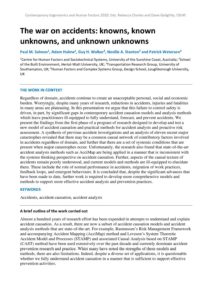| Document | Author Paul M. Salmon, Adam Hulme, Guy H. Walker, Neville A. Stanton and Patrick Waterson |
| Abstract Regardless of domain, accidents continue to create an unacceptable personal, social and economic burden. Worryingly, despite many years of research, reductions in accidents, injuries and fatalities in many areas are plateauing. In this presentation we argue that this failure to control safety is driven, in part, by significant gaps in contemporary accident causation models and analysis methods which leave practitioners ill-equipped to fully understand, forecast, and prevent accidents. We present the findings from the first phase of a program of research designed to develop and test a new model of accident causation and practical methods for accident analysis and proactive risk assessment. A synthesis of previous accident investigations and an analysis of eleven recent major catastrophes revealed that there may be a common causal network of contributory factors involved in accidents regardless of domain, and further that there are a set of systemic conditions that are present when major catastrophes occur. Unfortunately, the research also found that state-of-the-art accident analysis methods such as AcciMap are being applied in a manner that is inconsistent with the systems thinking perspective on accident causation. Further, aspects of the causal texture of accidents remain poorly understood, and current models and methods are ill-equipped to elucidate them. These include the role of normal performance in accidents, migration of work practices, feedback loops, and emergent behaviours. It is concluded that, despite the significant advances that have been made to date, further work is required to develop more comprehensive models and methods to support more effective accident analysis and prevention practices. |

